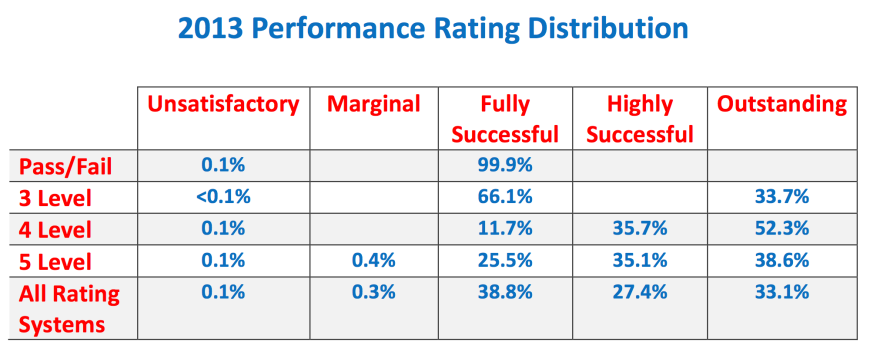

Too often, the assignment of a high number of outstanding ratings results in a lot of small performance awards that do little to motivate performance.
This column was originally published on Jeff Neal’s blog, ChiefHRO.com, and was republished here with permission from the author.
The Washington Post ran an article on June 13 highlighting a Government Accountability Office report on performance rating distribution for 2013. The Post and GAO pointed out that 74 percent of non-senior executive service rated under a five-level appraisal system received one of the top two ratings (usually defined as highly successful or outstanding. (Full disclosure: I was quoted in the article)
What I found most interesting about the numbers is the variation (or lack of it) between 2, 3, 4 and 5-level rating systems. Here is how the numbers look (adjectives used to describe the levels vary from agency to agency):
It is clear that no change of rating systems will increase the number of unsatisfactory ratings. Whether it is because of lack of training, lack of senior manager support, or just an unwillingness to give an employee a bad rating, the number of appraisal levels does not change the outcome on the bottom end.
Some folks will point to the consistency and say that means the systems work and the real number of employees with unsatisfactory performance is miniscule. In 33 years in federal HR, I saw countless managers who told me, my staff and my colleagues that they want to fire a poor performer, only to find out they gave that poor performer a fully successful rating. I don’t believe the number of unsatisfactory performers is 15 or 20 percent, but it is clearly much higher than 0.1 percent.
For me, the biggest takeaway is the fact that the presence of a better-than-OK rating means more than a third of supervisors will pick it. When they do, they do not have to explain to an employee why he or she is “only” fully successful and they do not have to justify an outstanding rating to their bosses. Given how many employees believe a fully successful rating is a bad rating, that is easy to understand. It does not make it right — just more explainable.

When that level is not available, those ratings go to fully successful. Surprisingly, the level scheme even has fewer outstanding ratings.
So — what should be done about federal performance ratings? Here are six things I think should be done to begin to make the process more realistic.
Appraisal processes should be limited to no more than three levels — unsatisfactory, satisfactory, and outstanding. In fact, we might find we would be better off with a simple pass/fail system with awards and recognition tied to specific and measurable accomplishments. Too often, the assignment of a high number of outstanding ratings results in a lot of small performance awards that do little to motivate performance. While it is obvious that pass/fail does not drive the number of unsatisfactory ratings up, at least it has the benefits of (a) eliminating the massive waste of time that the ratings process has devolved into, and (b) forcing agencies to have better justification for bonuses and awards.

One point I want to make is that the ratings process is not the unbiased and objective process so many people say it is. Here is why. As a manager, I can assign your work. I can decide who gets training and what kind of training you get. I can decide whether you get support from other employees or contractors (or none at all). I can decide what success looks like. And then I get to decide how you did. I have seen employees who were allegedly terrible suddenly become productive when they changed supervisors. I have also seen the opposite — a great employee with a proven track record whose new supervisor decides he or she is no good. Agencies hold all of the cards, and they can deal an employee any hand they please. Unless you are making widgets on an assembly line, slicing and dicing performance into the small divisions that multi-level appraisals require is not effective.
What we really need is a total rethinking of the process. I am not naive enough to believe there is a simple solution to the problem. It will take a lot of people representing different views to come up with what an appraisal process should be designed to accomplish, and then designing something that actually accomplishes it. Until that happens, nothing is going to change.
Jeff Neal is a senior vice president for ICF International and founder of the blog, ChiefHRO.com. Before coming to ICF, Neal was the chief human capital officer at the Department of Homeland Security and the chief human resources officer at the Defense Logistics Agency.
Copyright © 2024 Federal News Network. All rights reserved. This website is not intended for users located within the European Economic Area.
